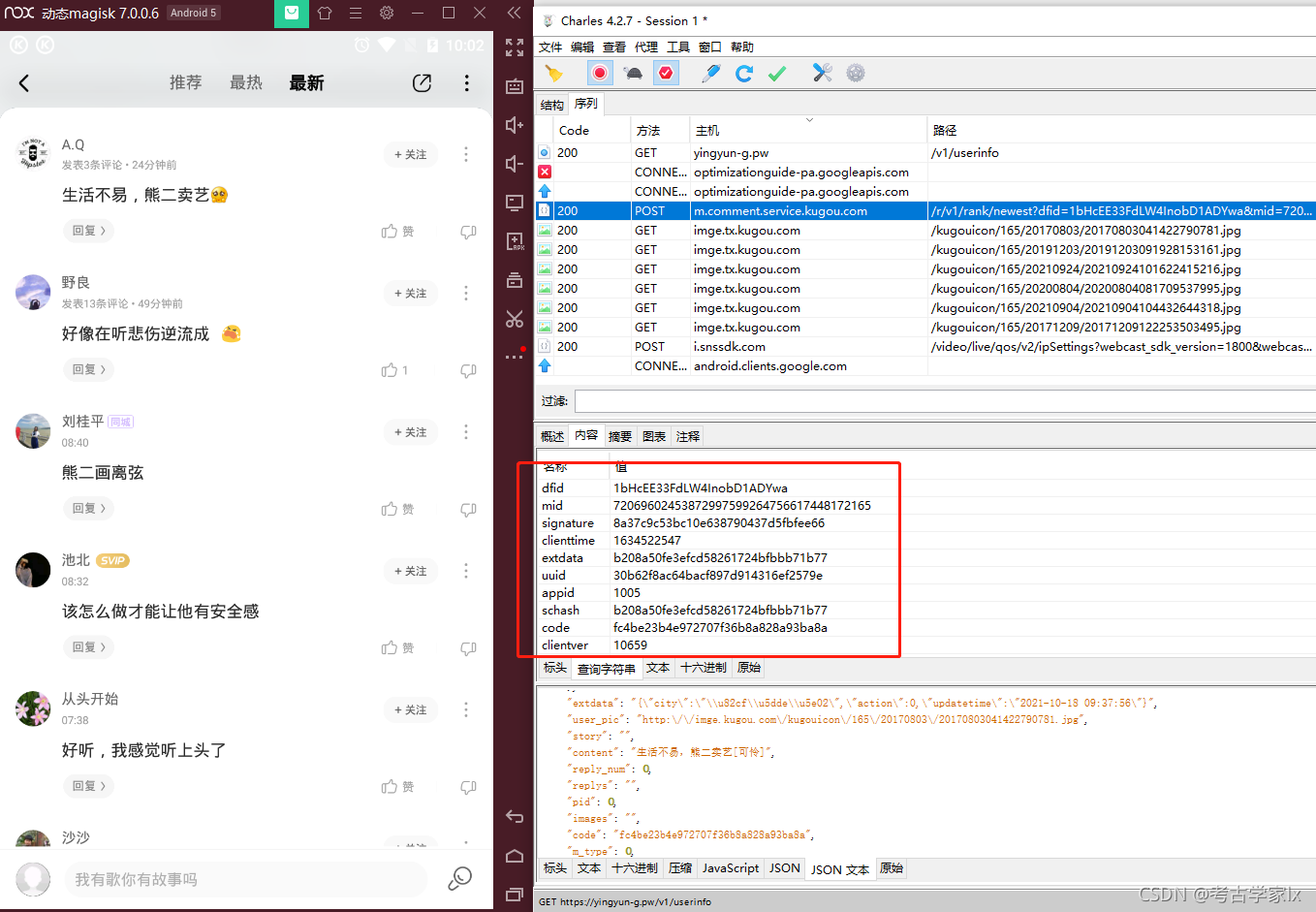酷狗app signature
本文案例是酷狗app的signature分析。
参数分析
所用环境:夜神模拟器7.0.0.6 ,系统版本安卓5,酷狗版本10.6.5 (模拟器推荐版本)

用Ak反编译后,在工程搜索中检索关键词 signature

发现检索出了很多的结果,根据经验判断signature和md5相关,所以更换检索词,检索 “md5” , 又是一大堆结果

此时快速定位参数位置的话,可以使用objection从内存中定位。或者通过frida输出当前所有使用md5的方法
在内存中所有已加载的方法中搜索包含特定关键词的方法:android hooking search methods [search_name]
经过一番人工操作,签名在 com.kugou.common.utils.ba 的b方法中生成
Frida hook
启动frida,查看应用名 com.kugou.android

编写hook代码
这里类中有很多同名b方法,所以需要overload重载。另外确定类型是String,所以参数类型为 ‘java.lang.String’
重载是指在同一个类内定义了多个相同的方法名称,但是每个方法的参数类型和参数的个数都不同。
在调用方法重载的函数编译器会根据所填入的参数的个数以及类型来匹配具体调用对应的函数。
import frida, sys
def on_message(message, data):
if message['type'] == 'send':
print("[*] {0}".format(message['payload']))
else:
print(message)
jscode_hook = """
Java.perform(
function(){
console.log("1. start hook");
var ba = Java.use("com.kugou.common.utils.ba");
if (ba != undefined) {
console.log("2. find class");
ba.b.overload('java.lang.String').implementation = function (a) {
console.log("计算参数a: " + a);
var res = ba.b(a);
console.log("计算result:" + res);
return res;
}
}
}
)
"""
process = frida.get_usb_device().attach('com.kugou.android')
script = process.create_script(jscode_hook)
script.on('message', on_message)
print('[*] Hook Start Running')
script.load()
sys.stdin.read()
- 1
- 2
- 3
- 4
- 5
- 6
- 7
- 8
- 9
- 10
- 11
- 12
- 13
- 14
- 15
- 16
- 17
- 18
- 19
- 20
- 21
- 22
- 23
- 24
- 25
- 26
- 27
- 28
- 29
- 30
- 31
- 32
- 33
运行hook代码

把输出的参数通过md5加密一下,和result进行验证

验证结果相同。signature即是参数进行拼接处理后的md5结果。
参数的开头和结尾加上了都OIlwieks参数。
生成示例
import time
clienttime = round(time.time())
dfid='10wxeO4AE9lK0Ek13L1LrvgC'
mid='304291870705239990160554795323375833919'
extdata='8616f71390c954c3f52bf53841fa4518'
uuid='cc133b26f7e7c93a89a4f7309002ddb2'
appid='1005'
schash='0930c43952c442a194129d20f48182fc'
code='fc4be23b4e972707f36b8a828a93ba8a'
clientver='10659'
mixsongid='274337675'
clienttoken='5841e1d4296732bd0015f52838bdae21bbfe0ded81d1960f0db7edae4d11f4fb'
ver='10'
kugouid='1887484938'
childrenid = '82117948'
p = '2'
pagesize = '20'
OIlwieks = '28dk2k092lksi2UIkp'
sign_params = f'OIlwieks{OIlwieks}appid={appid}childrenid={childrenid}clienttime={clienttime}clienttoken={clienttoken}clientver={clientver}code={code}dfid={dfid}extdata={extdata}kugouid={kugouid}mid={mid}mixsongid={mixsongid}p={p}pagesize={pagesize}uuid={uuid}ver={ver}OIlwieks{OIlwieks}'
import hashlib
m = hashlib.md5()
m.update(sign_params.encode(encoding='UTF-8'))
sign = m.hexdigest()
print(sign)
- 1
- 2
- 3
- 4
- 5
- 6
- 7
- 8
- 9
- 10
- 11
- 12
- 13
- 14
- 15
- 16
- 17
- 18
- 19
- 20
- 21
- 22
- 23
- 24
- 25
- 26
文章来源: blog.csdn.net,作者:考古学家lx,版权归原作者所有,如需转载,请联系作者。
原文链接:blog.csdn.net/weixin_43582101/article/details/120821077
- 点赞
- 收藏
- 关注作者


评论(0)